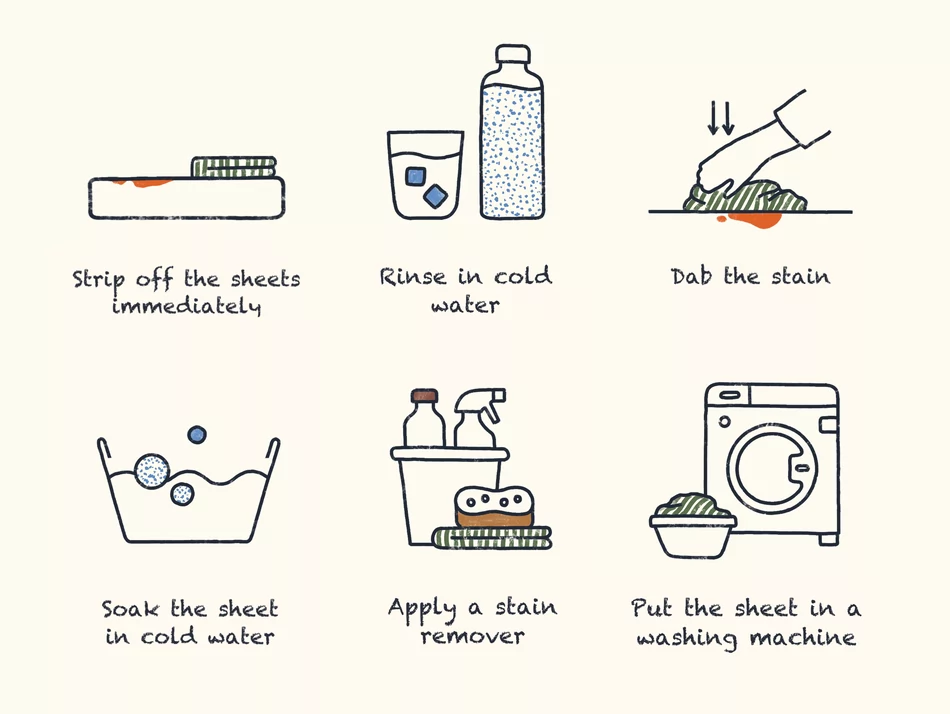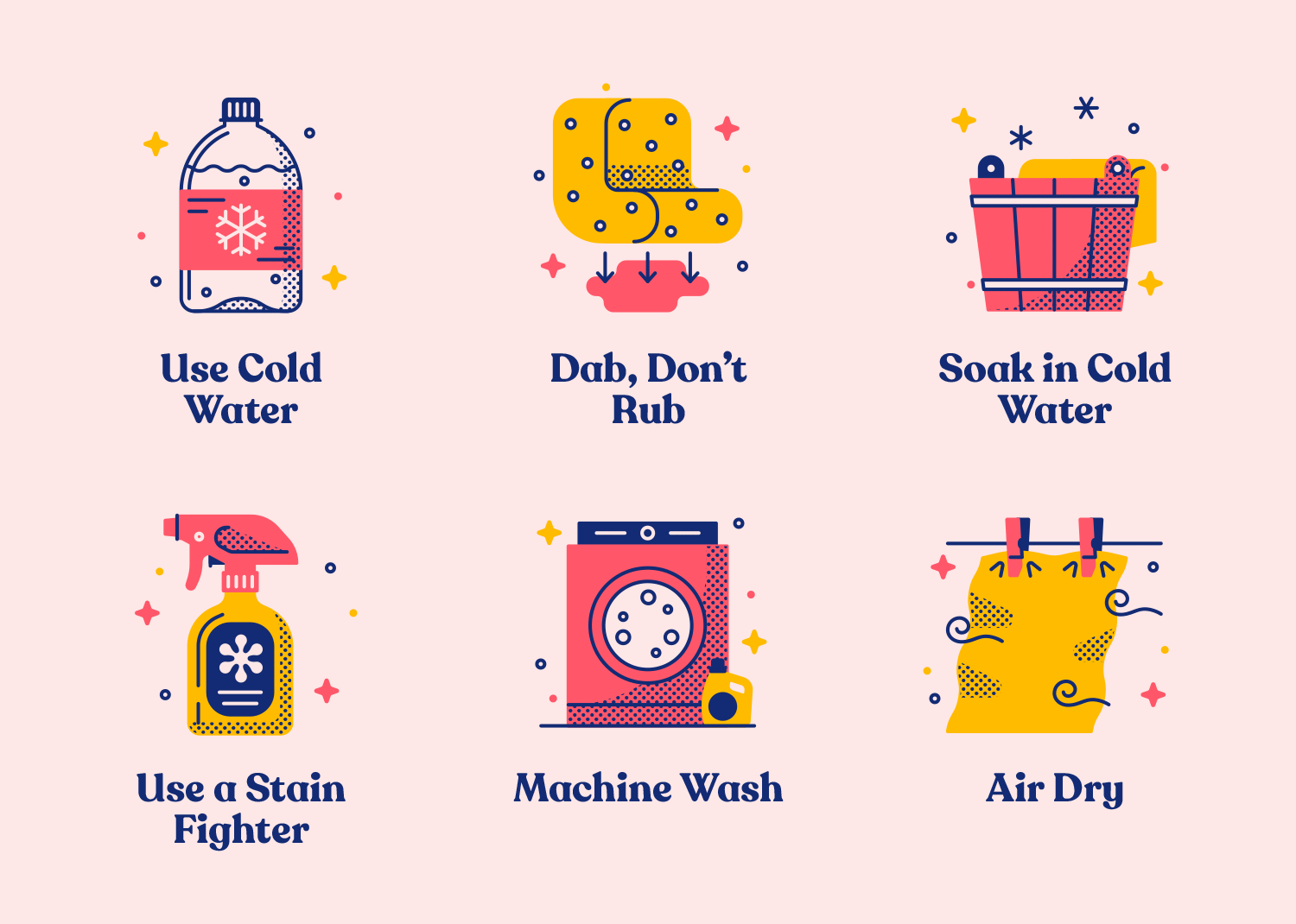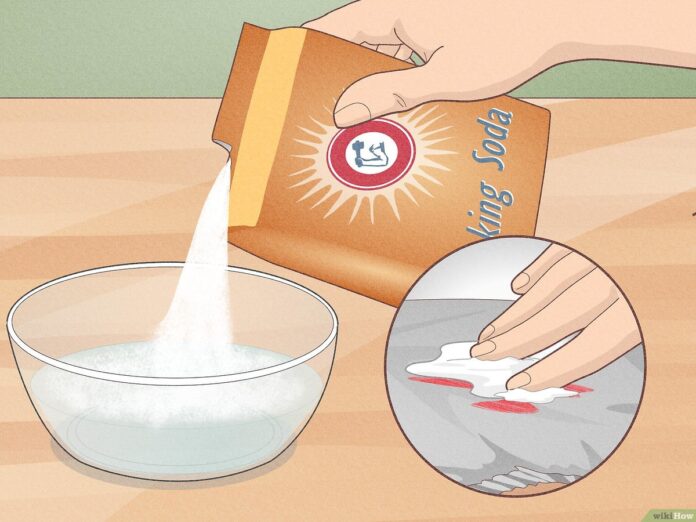To get blood out of sheets, immediately soak in cold water and apply a mixture of dish soap and hydrogen peroxide. Blood stains can be stubborn, but with quick action and the right cleaning methods, you can effectively remove them from your sheets.
Whether it’s a small spot or a larger stain, following these steps will help restore your sheets to their original condition. It’s important to act fast to prevent the blood from setting into the fabric. By using household items like dish soap and hydrogen peroxide, you can tackle the stain effectively and efficiently.
Now, let’s delve deeper into the process of removing blood stains from sheets.
Introduction To Stain Removal
Learn effective stain removal techniques for getting blood out of sheets. Discover simple yet powerful methods to eliminate stubborn blood stains and keep your sheets clean and fresh.
The Challenge Of Blood Stains
Blood stains on sheets can be quite challenging to remove, especially if they have dried or set into the fabric. Whether it’s a result of a minor accident, a nosebleed, or a menstrual mishap, dealing with blood stains requires quick and effective action. If left untreated, these stains can become stubborn and even permanent. However, with the right approach and proper preparation, you can successfully remove blood stains from your sheets.
Preparation For Effective Cleaning
Before diving into the stain removal process, it’s essential to prepare yourself and gather the necessary tools and materials. By doing so, you’ll increase your chances of effectively removing the blood stains from your sheets.
Here are some key steps to take before you begin:
- Gather the required supplies, such as cold water, mild detergent, hydrogen peroxide, a clean cloth, and a bowl.
- Blot the stain gently with a clean cloth or paper towel to remove any excess blood. Avoid rubbing the stain, as it can cause it to spread further into the fabric.
- Check the care label on your sheets for any specific instructions or restrictions on stain removal.
- If the sheets are white or colorfast, proceed with the stain removal process. If they are delicate or have sensitive dyes, consider testing the stain removal method on a small, inconspicuous area first to avoid any potential damage.
Once you have completed these preparatory steps, you are ready to tackle the blood stains on your sheets. In the next sections, we will explore effective methods and techniques to ensure successful stain removal.
Identifying The Type Of Sheets
Identifying the type of sheets is crucial when it comes to effectively removing blood stains. Different materials and colors require specific treatment to ensure the best results without damaging the fabric.
Material Matters
When dealing with blood stains on sheets, the type of material plays a significant role in determining the appropriate cleaning method. Cotton sheets are durable and can withstand more rigorous cleaning techniques, while silk sheets are delicate and require gentle handling. Polyester sheets are stain-resistant, making them easier to clean, but linen sheets may require extra care due to their tendency to wrinkle.
Color Considerations
The color of the sheets is another factor to consider. White sheets are more forgiving when it comes to stain removal, as they can withstand bleaching agents. However, colored or patterned sheets may require alternative stain removal methods to prevent fading or discoloration.
Immediate Actions To Take
Need to know how to get blood out of sheets? Follow these immediate actions: start by blotting the stain with cold water, then apply a mixture of hydrogen peroxide and dish soap. Rinse and repeat until the stain is gone.
Blot, Don’t Rub
When it comes to getting blood out of sheets, immediate action is key. The longer the stain sets, the harder it becomes to remove. So, as soon as you notice the blood stain, it’s important to take action. The first step is to blot the stain, not rub it. Blotting involves gently pressing a clean cloth or paper towel onto the stain to absorb as much of the blood as possible. Remember, do not rub the stain as it can spread the blood and make it more difficult to remove. Instead, use a dabbing motion to lift the stain from the fabric.
Cold Water Rinse
After blotting the blood stain, the next immediate action to take is a cold water rinse. Cold water helps to break down the blood proteins and prevent them from setting further into the fabric. To perform a cold water rinse: 1. Hold the stained area under cold running water. Make sure the water is as cold as possible. 2. Gently rub the fabric together to help loosen the stain. 3. Continue rinsing until the water runs clear and the stain starts to fade.
Remember, always use cold water for blood stains as hot water can actually set the stain and make it more difficult to remove. Taking these immediate actions of blotting and cold water rinsing can significantly improve the chances of removing blood stains from sheets. However, if the stain persists, don’t worry. There are still additional steps you can take to tackle stubborn blood stains. Stay tuned for our next section on further stain removal methods.
In conclusion, when it comes to getting blood out of sheets, immediate actions such as blotting the stain and performing a cold water rinse are crucial. These simple steps can help prevent the stain from setting and make it easier to remove. So remember, blot, don’t rub, and rinse with cold water for the best results.

Credit: www.dreamcloudsleep.com
Pre-treatment Solutions
When it comes to removing blood stains from sheets, pre-treatment solutions are key to effectively tackling the problem. By using the right methods and products, you can improve the chances of completely removing the stains and preserving the quality of your sheets. Here are some pre-treatment solutions that can help you in this process:
Enzyme-based Cleaners
Enzyme-based cleaners are highly effective in breaking down the proteins in blood stains, making them easier to remove. These cleaners contain enzymes that target and digest the proteins, effectively lifting the stain from the fabric. To use an enzyme-based cleaner, simply apply it directly to the stained area and allow it to sit for the recommended time before laundering the sheets.
Diy Stain Removers
If you prefer a more natural approach, DIY stain removers can be an effective pre-treatment solution for blood stains on sheets. A simple mixture of cold water and baking soda can be applied to the stained area, creating a paste that helps lift the blood from the fabric. Alternatively, a mixture of hydrogen peroxide and dish soap can also be effective in breaking down the blood stains before laundering.
Soaking Techniques
To remove blood from sheets, try soaking the stained area in cold water and a mixture of hydrogen peroxide and dish soap. Let it sit for 15-30 minutes, then wash as usual. For stubborn stains, use a paste of baking soda and cold water before soaking.
Timeframe For Soaking
When it comes to removing blood stains from sheets, time is of the essence. The longer the stain sits, the harder it becomes to remove. Acting quickly can make a significant difference in the success of stain removal. Ideally, you should start soaking the sheets as soon as you notice the stain.
For fresh blood stains, a soak of 30 minutes to an hour can often do the trick. However, for older or more stubborn stains, a longer soak may be necessary. In these cases, you can leave the sheets to soak for several hours or even overnight. This extended soaking time allows the cleaning solution to penetrate the fibers and break down the stain more effectively.
Temperature And Solutions
The temperature of the water used for soaking can greatly impact the stain removal process. For blood stains, it’s recommended to use cold water instead of hot. Hot water can actually set the stain and make it more difficult to remove. So, always opt for cold water when soaking blood-stained sheets.
In addition to cold water, there are various solutions you can use to enhance the stain-removing power. Here are a few effective options:
- Mixing a small amount of mild detergent with cold water can help break down the stain. Simply add a few drops of detergent to the soaking water and mix well.
- Vinegar is another versatile solution that can be used for blood stain removal. Create a mixture of equal parts cold water and white vinegar, and soak the sheets in it. The acidic properties of vinegar can help loosen the stain.
- If you prefer a more natural approach, you can try using a paste made of baking soda and cold water. Apply the paste directly to the stain and let it sit for a few minutes before soaking the sheets.
Remember to always follow the care instructions provided by the sheet manufacturer and test any solution on a small, inconspicuous area first to ensure it doesn’t damage the fabric.

Credit: purple.com
Mechanical Stain Removal Methods
Mechanical stain removal methods involve physical techniques to lift and remove blood stains from sheets. These methods are effective for fresh stains and can be gentler on the fabric compared to harsh chemical treatments.
Gentle Scrubbing
Gentle scrubbing is a safe and effective way to remove blood stains from sheets. Using a soft-bristled brush or sponge, gently scrub the stained area using circular motions. Avoid scrubbing too vigorously to prevent damaging the fabric.
Using A Toothbrush
For more targeted stain removal, a toothbrush can be an excellent tool. Dip the toothbrush in a mixture of cold water and mild detergent, then gently scrub the stained area. The soft bristles of the toothbrush can effectively lift the blood stain without causing damage to the fabric.
Washing Machine Settings
When it comes to Washing Machine Settings, selecting the right cycle is crucial.
Cycle Selection
Choose the appropriate cycle based on fabric type and stain severity.
- Regular Cycle: For everyday fabrics with light stains.
- Heavy-Duty Cycle: Ideal for tough stains on durable fabrics.
Detergents And Boosters
Use detergents and boosters to enhance stain removal effectiveness.
- Detergents: Select a high-quality detergent suitable for fabric type.
- Boosters: Add stain removers or boosters for stubborn stains.

Credit: casper.com
Post-wash Care
Discover effective post-wash care tips for removing blood stains from sheets. With simple techniques and common household items, you can easily restore the cleanliness and freshness of your bedding. Say goodbye to stubborn blood stains and enjoy a comfortable and pristine sleep environment.
When To Repeat The Process
Post-Wash Care: After washing blood-stained sheets, it’s crucial to ensure proper post-wash care to maintain their quality and cleanliness. Here are some essential steps to follow: – Check for any remaining stains – Air-dry the sheets – Avoid using high heat – Store only when fully dry
Drying Strategies
After washing, gently squeeze out excess water and lay the sheets flat to air dry. Avoid direct sunlight to prevent discoloration.
When To Repeat The Process
If any blood stains remain after the first wash, repeat the process before drying to prevent setting the stain further.
Preventing Future Stains
To prevent future stains on your sheets, it’s essential to act fast when dealing with blood. Start by soaking the sheets in cold water and using a mixture of salt and water to treat the affected area. Afterward, wash the sheets with an enzyme-based detergent to ensure the stain is completely removed.
Routine Sheet Maintenance
Preventing Future Stains Protect your sheets with protective covers to avoid direct contact with spills. Regularly wash your sheets to maintain their freshness and quality. Use protective covers to prevent direct contact with spills. Regularly wash your sheets to keep them clean. Protective covers can be a shield against stains. Maintain the freshness and quality of your sheets through regular washing.
When To Call Professionals
When it comes to getting blood out of sheets, it is best to call professionals who have the expertise and tools to handle the task effectively. They can ensure that the stain is properly treated and removed without causing any damage to the fabric.
Avoid further complications and let the professionals take care of it.
Assessing The Damage
Before resorting to professional help, evaluate the extent of the bloodstains on your sheets.
Consider factors like the size of the stains and the type of fabric to determine if professional assistance is necessary.
Professional Cleaning Services
If the bloodstains are extensive or deeply set, it might be best to seek the expertise of professional cleaners.
Professional cleaning services have specialized techniques and products to effectively remove stubborn blood stains.
They can ensure the sheets are thoroughly cleaned without damaging the fabric or compromising the quality.
Frequently Asked Questions
Q: How Do I Get Blood Out Of Sheets?
A: The best way to get blood out of sheets is to soak the affected area in cold water for at least 30 minutes. Then, apply a mixture of salt and water on the stain and let it sit for another 30 minutes before washing the sheets in cold water.
Q: Can I Use Hot Water To Remove Blood Stains From Sheets?
A: No, using hot water to remove blood stains from sheets can actually set the stain and make it harder to remove. Always use cold water when treating blood stains.
Q: What Household Items Can I Use To Remove Blood From Sheets?
A: You can use common household items like salt, hydrogen peroxide, and vinegar to remove blood from sheets. These items are effective and safe to use on most fabrics.
Q: Can I Use Bleach To Remove Blood Stains From Sheets?
A: Bleach is not recommended for removing blood stains from sheets as it can damage the fabric and make the stain worse. Instead, use a mixture of cold water and salt or hydrogen peroxide.
Conclusion
Removing blood stains from sheets can be a daunting task, but with these tips, it doesn’t have to be. Whether you choose to use hydrogen peroxide or a mixture of dish soap and salt, the key is to act quickly and not let the stain set.
Remember to always test a small, inconspicuous area before applying any cleaning solution to the entire stain. With a little patience and persistence, you can easily get blood out of sheets and keep them looking fresh and clean.


